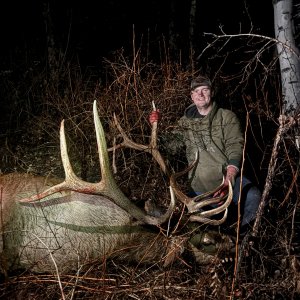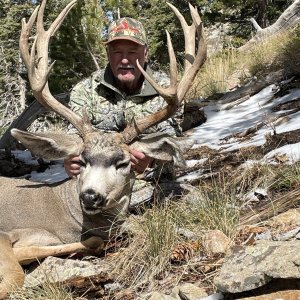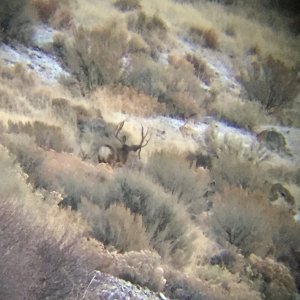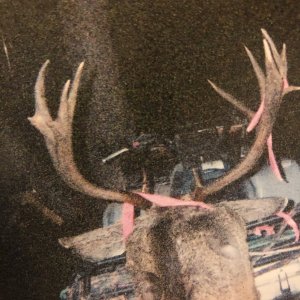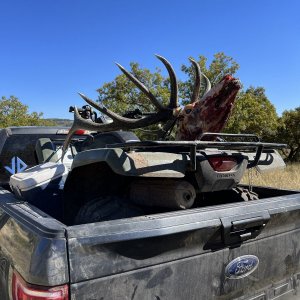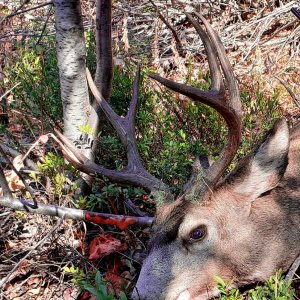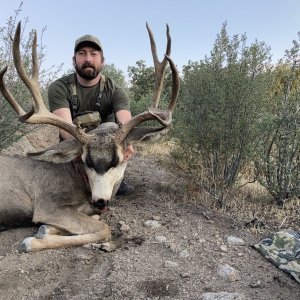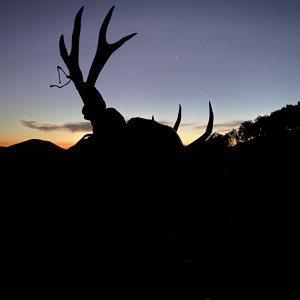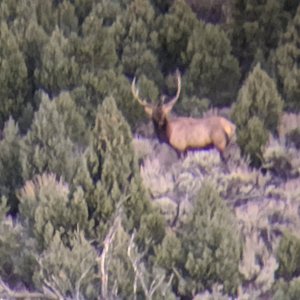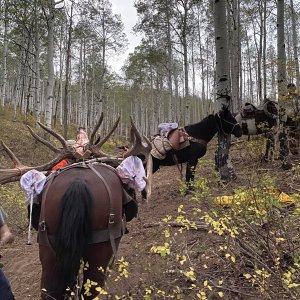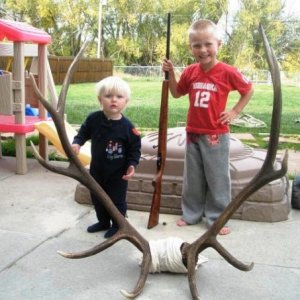You are using an out of date browser. It may not display this or other websites correctly.
You should upgrade or use an alternative browser.
You should upgrade or use an alternative browser.
Question for tuleelk
- Thread starter 972Elk
- Start date
tuleelk
Active Member
- Messages
- 133
Typically the pre-rut starts in early August. I asked the unit biologist over in Bishop what he typically sees in that area and he told me the rut starts earliest in Lone Pine (south) and begins at later dates moving towards the north. First week of August through end of September. These dates can move a bit depending on the year, weather, but are good rules to go by. Hope that helps.
Joe
Joe
>".......I asked the unit
>biologist over in Bishop what
>he typically sees in that
>area and he told me......he mostly only sees the walls of his office and is not really sure how to GET to Lone Pine"
That is hiliarious! But thanks for asking!
"whackin' a surly bartender ain't much of a crime"
>biologist over in Bishop what
>he typically sees in that
>area and he told me......he mostly only sees the walls of his office and is not really sure how to GET to Lone Pine"
That is hiliarious! But thanks for asking!
"whackin' a surly bartender ain't much of a crime"
Paul_Crawford
Long Time Member
- Messages
- 3,578
Don, you're incorrigible!! lol pc
pschultheis
Member
- Messages
- 55
My buddy Don is right. I spent 4 nights in Lone Pine scouting and 11 hunting last year for a total of 15. We never saw or heard from the biologist. I know in other areas it is much diffeent. From my limited experience, last year, the rut is/was hot and heavy the last week in August and the first of September.
Hope that helps,
Paul
Hope that helps,
Paul
tuleelk
Active Member
- Messages
- 133
Ok,
I just checked my in box and had messages from over 2 years ago. I apologize for not getting back to you all but I never really check messages here, or never had (that I can remember). If anyone has any questions call me or email me and I will try to answer them.
Joe
916 445-9992
[email protected]
I just checked my in box and had messages from over 2 years ago. I apologize for not getting back to you all but I never really check messages here, or never had (that I can remember). If anyone has any questions call me or email me and I will try to answer them.
Joe
916 445-9992
[email protected]
OK, I am an azz for picking on the resident biologist...RB. I admit it, but I ain't going to stop.
Here's the deal.
Our DFG is a bedroom in the State's cathouse.
This department is so overloaded with middle and upper level managers, that there are not enough funds for dirt level employees....not the RB's fault.
The RB for this area, has responsibility for some 13,335 sq miles....an area larger than about 8 individual States in this country! He has to work with/for ALL fish and animals in the region. There is no money for overtime; his miles are controlled and his gas is limited.....not the RB's fault.
For over 30 years, most of the information on animal population, location and reproduction, has been based on the guesswork of the, always underfunded, RB.....sort of not the RB's fault. They seldom leave the office and are as rare a sighting in the field, around the valley, as an albino water buffalo.
The problem is, these RB's come here and simply refuse to accept the help of ranchers, sportsmen, resident birdwatchers or whatever. Their attitude is, if they don't see it, then it is an "unsubstiantiated" report.....never mind going after the facts!
The bottom line is, Sacramento bases tags, seasons and zones on the bogus information the RB's provide. That is wrong, but it never changes. Sort of the RB's fault.....business as usual, why change? I hold Sacramento responsible here as well, but the RB is the man on sight.
We have a Federal Mandate on the number of elk this valley is allowed. We are probably 30% above that mandate, but, who cares? There is no money to do a comprehensive count anyway, so what's the difference?
EXAMPLE; We have a herd of 30+,batchelor bull elk, fully mature and healthy, that are so overcrowded, they don't participate in the rut whatsoever. Can't hunt them though....don't ask why.
I posted a picture of this herd last year, but since the RB never saw them they must not exist.....so there are NO tags issued for that zone, any longer.....unsubstantiated report. Definately the RB's fault!
The ranchers, hunters and other groups have tried to get this guy lined out, with no result. He refuses to invest his own time to gain accurate information on the area and it's critters. No passion for the job.
Over the past 3 years, he has spread more misinformation than a Russian newspaper, but since he is the RB, he must be right,,,,,right?
My opinion, along with several others, is that the man has one of the best jobs in the State, in one of the best areas of the State, but lacks any passion for the job.
The mere fact that thousands of hunters are depending on his information to help them, is not relavent. He has clearly taken PR lessons from wherever our resident Wardens got theirs.
I will cut the guy no slack until he invests his own time to learn what he needs to know.....or packs it in and goes somewhere else if he don't like it here.
I can find 10 people to back me up for every 1 tule elk he can show you!
Nothing will change, and I, quite frankly, no longer give a red rats azz if it does or not.
"whackin' a surly bartender ain't much of a crime"
Here's the deal.
Our DFG is a bedroom in the State's cathouse.
This department is so overloaded with middle and upper level managers, that there are not enough funds for dirt level employees....not the RB's fault.
The RB for this area, has responsibility for some 13,335 sq miles....an area larger than about 8 individual States in this country! He has to work with/for ALL fish and animals in the region. There is no money for overtime; his miles are controlled and his gas is limited.....not the RB's fault.
For over 30 years, most of the information on animal population, location and reproduction, has been based on the guesswork of the, always underfunded, RB.....sort of not the RB's fault. They seldom leave the office and are as rare a sighting in the field, around the valley, as an albino water buffalo.
The problem is, these RB's come here and simply refuse to accept the help of ranchers, sportsmen, resident birdwatchers or whatever. Their attitude is, if they don't see it, then it is an "unsubstiantiated" report.....never mind going after the facts!
The bottom line is, Sacramento bases tags, seasons and zones on the bogus information the RB's provide. That is wrong, but it never changes. Sort of the RB's fault.....business as usual, why change? I hold Sacramento responsible here as well, but the RB is the man on sight.
We have a Federal Mandate on the number of elk this valley is allowed. We are probably 30% above that mandate, but, who cares? There is no money to do a comprehensive count anyway, so what's the difference?
EXAMPLE; We have a herd of 30+,batchelor bull elk, fully mature and healthy, that are so overcrowded, they don't participate in the rut whatsoever. Can't hunt them though....don't ask why.
I posted a picture of this herd last year, but since the RB never saw them they must not exist.....so there are NO tags issued for that zone, any longer.....unsubstantiated report. Definately the RB's fault!
The ranchers, hunters and other groups have tried to get this guy lined out, with no result. He refuses to invest his own time to gain accurate information on the area and it's critters. No passion for the job.
Over the past 3 years, he has spread more misinformation than a Russian newspaper, but since he is the RB, he must be right,,,,,right?
My opinion, along with several others, is that the man has one of the best jobs in the State, in one of the best areas of the State, but lacks any passion for the job.
The mere fact that thousands of hunters are depending on his information to help them, is not relavent. He has clearly taken PR lessons from wherever our resident Wardens got theirs.
I will cut the guy no slack until he invests his own time to learn what he needs to know.....or packs it in and goes somewhere else if he don't like it here.
I can find 10 people to back me up for every 1 tule elk he can show you!
Nothing will change, and I, quite frankly, no longer give a red rats azz if it does or not.
"whackin' a surly bartender ain't much of a crime"
tuleelk
Active Member
- Messages
- 133
I am not going to get into a dicsussion over peoples opinions. Opinions are based on what people see and feel, opinions are not wrong (what is going on may be different but that does not make the opinion wrong). But, we do base tag quotas on counts. To the extent possible, these counts are conducted in a routine manner each year. Not saying we never miss anything or such. The tag numbers and seasons in the Owens Valley have changed over the last few years. We added new periods, divided zones, etc to try to harvest more elk in the appropriate areas, etc. Is it a perfect system, no. Our hands are tied to some degree. In January we put 9 gps collars on elk in the OV to determine where these animals were going throughout the year. We learn new things all the time from gps collars. I know people are always trying to help and not saying they are wrong, but I will not base tag quotas on something someone told me. Honestly think about it, I stand up at the Commission adoption meeting and say Mr. Smith told me that there were more elk than we thought so I have increased the tag quota. That simply is not going to fly. Now that being said I do think we can try to work with people to look at what they are reporting. Heck, that is how I learn a lot of new things. But also view it from my point of view. I get two phone calls from hunters who hunted the same unit with the same tag at the same time. One tells me he had a great time saw lots of elk and had his pick of what animal he wanted. The next guy said he never saw an elk, the unit sucks and we do not know what we are doig. Who is right? Is one of them lying? This type of stuff happens all the time. We fly surveys for elk in some areas and ground counts in the others. Could they be improved, probably (and we try to do that). Surveys need to be conducted, to the extent possible, in a repeatable manner otherwise there is no reliable trend data. I have had ranchers call me up and yell at me for the 200 elk in their field, etc. I go out there and it is actually 40 elk. It is not that he is lying he just did not actually count them, he was mad saw a lot of elk and came up with a number. All these things must be taken into consideration. Relying on someone elses numbers be they correct or wrong is something we can not use to conduct business. Again, that is not saying it is not useful, we may be able to try to alter counts, timing, etc to try to incorporate the new information and verify it. I will be the first to admit the system is not perfect but I think people need to look at it from a larger perspective. If anyone has any questions or concerns please call me and I will try to answer them. I am open to suggestions and do not think I have all the answers (but do not tell my wife that, she thinks I am wrong most of the time).
Joe
916 445-9992
Joe
916 445-9992
First off, I have no desire to get into an arguement with Joe.
I have read and heard many of his reports and I truely believe he is one of the VERY good guys at DFG.
Unfortunately, Tule elk do not stand around in the hot sun waiting for the DFG to start their day at 8 am.
You cannot really think, that a count taken on July 7th at 11am, quite possibly the hottest day and time of the year, is going to allow you to see animals from the air. They did see 25 out of approximately 300, so I guess that's something.
Ground surveys conducted at similar times will provide similar results.
When someone offers to SHOW DFG what they are seeing, it would seem reasonable to look into the issue during the period in which the elk are active, and that ain't 8am to 5pm.
Sorry, but the Big Game Booklet should read....."this is what we see during normal business hours. Individual results may vary"........But hey, the DFG guys are the "Resident Biologists", so they must be right!............right?
Let me just say this; California's Department of Fish and Game does not have the resources to do this right......so they do it wrong..... and we get the "koolaid".
It will not matter in a few more years anyway. There is a movement to remove them from the Owens Valley, since they are not a "native species".....the Santa Rosa Island situation.
"whackin' a surly bartender ain't much of a crime"
I have read and heard many of his reports and I truely believe he is one of the VERY good guys at DFG.
Unfortunately, Tule elk do not stand around in the hot sun waiting for the DFG to start their day at 8 am.
You cannot really think, that a count taken on July 7th at 11am, quite possibly the hottest day and time of the year, is going to allow you to see animals from the air. They did see 25 out of approximately 300, so I guess that's something.
Ground surveys conducted at similar times will provide similar results.
When someone offers to SHOW DFG what they are seeing, it would seem reasonable to look into the issue during the period in which the elk are active, and that ain't 8am to 5pm.
Sorry, but the Big Game Booklet should read....."this is what we see during normal business hours. Individual results may vary"........But hey, the DFG guys are the "Resident Biologists", so they must be right!............right?
Let me just say this; California's Department of Fish and Game does not have the resources to do this right......so they do it wrong..... and we get the "koolaid".
It will not matter in a few more years anyway. There is a movement to remove them from the Owens Valley, since they are not a "native species".....the Santa Rosa Island situation.
"whackin' a surly bartender ain't much of a crime"
Wiszard
Long Time Member
- Messages
- 10,904
Nickman- So what you are saying is that I should make my way up there and poach one of these guys while they're still around? LOL....kidding, of course!
We have too few dirt level guys for the amount of ground they gotta cover throughout California...that is for sure.
Steve
Derkha derkha Muhammed jihad hakha sherpha sherpha abakhala- Gary of Team America World Police
We have too few dirt level guys for the amount of ground they gotta cover throughout California...that is for sure.
Steve
Derkha derkha Muhammed jihad hakha sherpha sherpha abakhala- Gary of Team America World Police
Paul_Crawford
Long Time Member
- Messages
- 3,578
Don, I thought Tule Elk were all over California at one time. PC
califhuntn
Active Member
- Messages
- 793
The sad part is that if you look at the income that fishing & hunting brings into this state with the potential to bring in even more there should be more than enough money to properly manage these resources and to be self sustaining. But it sounds like that is not the case.
On another note the comment made in a previous post about getting rid of the tule elk in Owens Valley because they are not native is absolute bullchit. Are you kidding me. There are species all over the US being transplanted that were never native to begin with. What a joke.
JR
On another note the comment made in a previous post about getting rid of the tule elk in Owens Valley because they are not native is absolute bullchit. Are you kidding me. There are species all over the US being transplanted that were never native to begin with. What a joke.
JR
Tule elk were never native to the Owens Valley. While they do survive pretty well here, they have been unable to adapt to the lack of various minerals, not available in this region. Poor antler strength is one of the problems.
Another DFG non-issue....the elk in areas where ranchers suppliment mineral block for cattle, have stronger antlers....but that is another "unsubstantiated" report of no value.
The "nature fakers" are going for the "Pre European" condition of the country as a whole.....but since California has more "nature fakers", they will clean it up first.
"whackin' a surly bartender ain't much of a crime"
Another DFG non-issue....the elk in areas where ranchers suppliment mineral block for cattle, have stronger antlers....but that is another "unsubstantiated" report of no value.
The "nature fakers" are going for the "Pre European" condition of the country as a whole.....but since California has more "nature fakers", they will clean it up first.
"whackin' a surly bartender ain't much of a crime"
tylercreek2
Very Active Member
- Messages
- 1,918
>>>Jump to: navigation, search
Tule Elk
female Tule elk
Scientific classification
Kingdom: Animalia
Phylum: Chordata
Class: Mammalia
Order: Artiodactyla
Suborder: Ruminantia
Family: Cervidae
Subfamily: Cervinae
Genus: Cervus
Species: C. canadensis
Subspecies: C. c. nannodes
Trinomial name
Cervus canadensis nannodes
Male Tule elkThe tule elk (Cervus canadensis nannodes) is a subspecies of elk found only in California, ranging from the grasslands and marshlands of the Central Valley to the grassy hills on the coast.[1] The subspecies name derives from the tule that it feeds off of, which grows in the marshlands. It is the smallest subspecies of all American elks, with the average weight of adult males only 450 - 550 pounds. The females average 375 - 425 pounds. The calves are similar to deer fawns, with brown coat and white spots. When the Europeans first arrived, an estimate of 500,000 tule elk roamed these regions. But by 1895, habitat loss and hunting had reduced the elk population to only 28.[2] Conservation measures were taken to protect the species in the 1970s.[3] Today the wild population exceeds 4,000.[2] Tule elk can reliably be found in Carrizo Plain National Monument, Point Reyes National Seashore, and portions of the Owens Valley from Lone Pine to Bishop.
Contents [hide]
1 History
2 See also
3 References
4 External links
[edit] HistoryThe smallest of the wapiti in North America, the tule (too-lee) elk were the dominant large ungulate in California prior to the arrival of the Spanish.
Half the size of the Roosevelt elk, the tule elk is also known as the dwarf elk.
The arrival of the Spanish in the late 18th century caused the release of cattle and horses on the grasslands of the Central Valley. In the 1830's, Americans attracted by the abundance of Spanish cattle, sent ships to California to land men who went ashore to kill the cattle for the hide and tallow trade. In a short time, this trade removed much of the cattle from California so when the first emigrants arrived from the United States they hunted the abundant elk and other species in the absence of a livestock industry.
The gold rush of 1849 brought in musket hunters, trappers and cattle barons. Twenty-four years later, in 1873 the once great herds were reduced to a single tiny band.
Henry Miller, a California rancher, discovered a tiny remnant in his tule marshes and ordered his men to protect them. After his death the huge Miller-Lux ranch was subdivided and the hunting of the elk resumed. The population was reduced to 72 head. In the years that followed, the elk were transplanted 21 times with each attempt failing.
In 1933, a rancher named Walter Dow took a small group of penned elk to his ranch in Owens Valley, east of the Sierra. Although not native habitat for the elk, they thrived. In this same year, the state put a small herd at Cache Creek. This herd has not fared well due to poor range conditions. It is also believed by some that this herd may have interbred with the introduced Rocky Mountain Elk which were introduced near Mount Shasta.
In 1960, the State held a hearing in Owens Valley to determine how many elk should be allowed to live there. It was decided that the elk should be hunted to limit their numbers to under 500 animals.
A person present from Los Angeles, Beula Edmiston, formed a group to attempt a preservation program for the Elk.
After more than ten years of lobbying both on the Federal and State level, in 1971 California passed legislation requiring that the elk may not be hunted until their numbers surpass 2,000 head statewide and mandated the Caifornia Department of Resources to reintroduce the Elk into former habitat wherever possible. Federal legislation followed in 1976.
As of 1998, it is estimated that the current population of the tule Elk is 3,200 and growing.[1] This vulnerable subspecies of elk still roam the coastal areas as well as the marshlands and grasslands of California's interior. Though the tule elk?s population is currently not declining, California?s human population is growing, and the tule elk have fewer and fewer places to roam. The small amount of suitable elk habitat and human population growth will likely cause the tule elk's population to remain in a balanced population pool, without an increase in population growth nor a decline. However, if humans do find ways to encroach on the Elk?s habitat and settle (e.g. clear marshlands for settlement, pass Bills to hunt the tule elk above the current limit), then there will certainly be a decline in the tule elk?s population.<<<
kinda interesting
Tule Elk
female Tule elk
Scientific classification
Kingdom: Animalia
Phylum: Chordata
Class: Mammalia
Order: Artiodactyla
Suborder: Ruminantia
Family: Cervidae
Subfamily: Cervinae
Genus: Cervus
Species: C. canadensis
Subspecies: C. c. nannodes
Trinomial name
Cervus canadensis nannodes
Male Tule elkThe tule elk (Cervus canadensis nannodes) is a subspecies of elk found only in California, ranging from the grasslands and marshlands of the Central Valley to the grassy hills on the coast.[1] The subspecies name derives from the tule that it feeds off of, which grows in the marshlands. It is the smallest subspecies of all American elks, with the average weight of adult males only 450 - 550 pounds. The females average 375 - 425 pounds. The calves are similar to deer fawns, with brown coat and white spots. When the Europeans first arrived, an estimate of 500,000 tule elk roamed these regions. But by 1895, habitat loss and hunting had reduced the elk population to only 28.[2] Conservation measures were taken to protect the species in the 1970s.[3] Today the wild population exceeds 4,000.[2] Tule elk can reliably be found in Carrizo Plain National Monument, Point Reyes National Seashore, and portions of the Owens Valley from Lone Pine to Bishop.
Contents [hide]
1 History
2 See also
3 References
4 External links
[edit] HistoryThe smallest of the wapiti in North America, the tule (too-lee) elk were the dominant large ungulate in California prior to the arrival of the Spanish.
Half the size of the Roosevelt elk, the tule elk is also known as the dwarf elk.
The arrival of the Spanish in the late 18th century caused the release of cattle and horses on the grasslands of the Central Valley. In the 1830's, Americans attracted by the abundance of Spanish cattle, sent ships to California to land men who went ashore to kill the cattle for the hide and tallow trade. In a short time, this trade removed much of the cattle from California so when the first emigrants arrived from the United States they hunted the abundant elk and other species in the absence of a livestock industry.
The gold rush of 1849 brought in musket hunters, trappers and cattle barons. Twenty-four years later, in 1873 the once great herds were reduced to a single tiny band.
Henry Miller, a California rancher, discovered a tiny remnant in his tule marshes and ordered his men to protect them. After his death the huge Miller-Lux ranch was subdivided and the hunting of the elk resumed. The population was reduced to 72 head. In the years that followed, the elk were transplanted 21 times with each attempt failing.
In 1933, a rancher named Walter Dow took a small group of penned elk to his ranch in Owens Valley, east of the Sierra. Although not native habitat for the elk, they thrived. In this same year, the state put a small herd at Cache Creek. This herd has not fared well due to poor range conditions. It is also believed by some that this herd may have interbred with the introduced Rocky Mountain Elk which were introduced near Mount Shasta.
In 1960, the State held a hearing in Owens Valley to determine how many elk should be allowed to live there. It was decided that the elk should be hunted to limit their numbers to under 500 animals.
A person present from Los Angeles, Beula Edmiston, formed a group to attempt a preservation program for the Elk.
After more than ten years of lobbying both on the Federal and State level, in 1971 California passed legislation requiring that the elk may not be hunted until their numbers surpass 2,000 head statewide and mandated the Caifornia Department of Resources to reintroduce the Elk into former habitat wherever possible. Federal legislation followed in 1976.
As of 1998, it is estimated that the current population of the tule Elk is 3,200 and growing.[1] This vulnerable subspecies of elk still roam the coastal areas as well as the marshlands and grasslands of California's interior. Though the tule elk?s population is currently not declining, California?s human population is growing, and the tule elk have fewer and fewer places to roam. The small amount of suitable elk habitat and human population growth will likely cause the tule elk's population to remain in a balanced population pool, without an increase in population growth nor a decline. However, if humans do find ways to encroach on the Elk?s habitat and settle (e.g. clear marshlands for settlement, pass Bills to hunt the tule elk above the current limit), then there will certainly be a decline in the tule elk?s population.<<<
kinda interesting
C
coyote1
Guest
I have called Mike (the RB to some people) three times this year and each time I talked to him while he was in the field. The first two times he was doing deer counts and the last time (yesterday), he was out counting elk in the Independence zone. This guy spends more time in the field than any other biologist in California. I called him two years ago to tell him of a herd of elk in the Bishop zone and he left his office to personally see them. I also camped out with him one night in the Lone Pine zone. We slept in the back of our trucks so we could be there at first light. The reason we have a Tinnemaha Mountain zone is because he personally hiked up into that zone and saw all of those bulls. Mike is a friend to all of us who love to hunt in the Owens Valley. Sacramento is where the blame needs to be directed. Not at the RB
Similar threads
California Guides & Outfitters
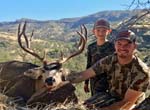 Western Wildlife Adventures
Western Wildlife Adventures
Offering some fine Blacktail Deer hunting, Wild Pig hunts, Turkey hunts and Waterfowl hunts.
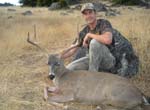 Urge 2 Hunt
Urge 2 Hunt
We offer the top private land hunts in all of California, for blacktail deer, elk, pigs, bison and turkeys.
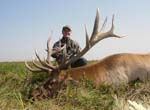 G & J Outdoors
G & J Outdoors
Offering Tule elk hunts for bulls and cows on a 17,000 acre Ranch in Laytonville, CA with 100% success.

